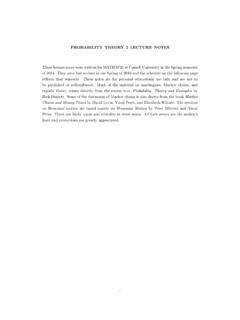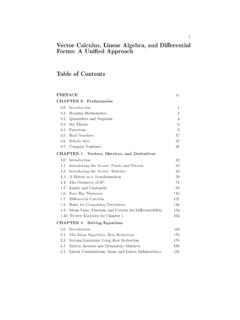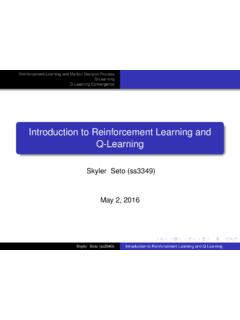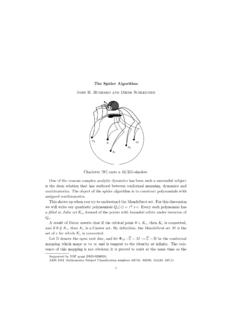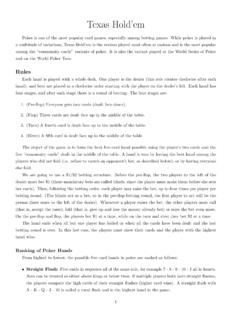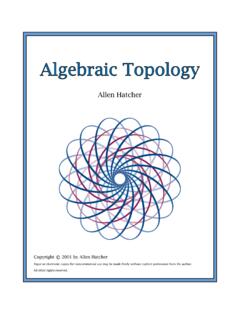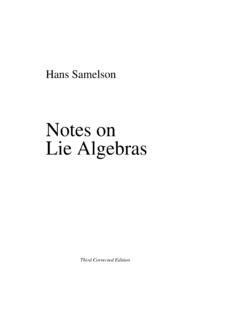Transcription of Notes on Introductory Point-Set Topology
1 Notes on Introductory Point-Set TopologyAllen HatcherChapter 1. Basic Point-Set Topology .. 1 Topological Spaces 1, Interior, Closure, and Boundary 5, Basis for a Topology7, Metric Spaces 8, Subspaces 9, Continuity and Homeomorphisms 11, ProductSpaces 12, Exercises 14 Chapter 2. Connectedness.. 16 Path-connected Spaces 17, Cut points 18, Connected Components and Path Com-ponents 19, The Cantor Set 22, Exercises 25 Chapter 3. Compactness.. 27 Compact Sets in Euclidean Space 28, Hausdorff Spaces 30, Normal Spaces 32,Lebesgue Numbers 34, Infinite Products 35, Exercises 37 Chapter 4.
2 Quotient Spaces.. 40 The Quotient Topology 41, Surfaces 47, Exercises 51 Basic Point-Set Topology1 Chapter 1. Basic Point-Set TopologyOne way to describe the subject of Topology is to say that it isqualitative geom-etry. The idea is that if one geometric object can be continuously transformed intoanother, then the two objects are to be viewed as beingtopologicallythe same. Forexample, a circle and a square are topologically equivalent. Physically, a rubber bandcan be stretched into the form of either a circle or a square, as well as many othershapes which are also viewed as being topologically equivalent.
3 On the other hand, afigure eight curve formed by two circles touching at a point isto be regarded as topo-logically distinct from a circle or square. A qualitative property that distinguishes thecircle from the figure eight is the number of connected piecesthat remain when asingle point is removed: When a point is removed from a circlewhat remains is stillconnected, a single arc, whereas for a figure eight if one removes the point of contactof its two circles, what remains is two separate arcs, two separate term used to describe two geometric objects that are topologically equivalentishomeomorphic.
4 Thus a circle and a square are homeomorphic. Concretely, ifweplace a circleCinside a squareSwith the same centerpoint, then projecting the circle radially outward to thesquare defines a functionf:C S, and this function iscontinuous: small changes inxproduce small changes inf (x). The functionfhas an inversef 1:S Cobtainedby projecting the square radially inward to the circle, andthis is continuous as well. One says thatfis a homeo-morphism of the basic problems of Topology is to determine when twogiven geometricobjects are homeomorphic. This can be quite difficult in first goal will be to define exactly what the geometric objects are that onestudies in Topology .
5 These are calledtopological spaces. The definition turns out tobe extremely general, so that many objects that are topological spaces are not verygeometric at all, in SpacesRather than jump directly into the definition of a topological space we will firstspend a little time motivating the definition by discussing the notion of continuity of afunction. One could say that topological spaces are the objects for which continuousfunctions can be the sake of simplicity and concreteness let us talk aboutfunctionsf:R are two definitions of continuity for such a function that the reader may alreadybe familiar with, the - definition and the definition in terms of limits.
6 But it is a2 Chapter 1third definition, equivalent to these two, that is the one we want here. This definitionis expressed in terms of the notion of an open set inR, generalizing the familiar ideaof an open interval(a, b). subsetOofRisopenif for each pointx Othere exists an interval(a, b)that containsxand is contained this definition an open interval certainly qualifies as an open set. Otherexamples are:Ritself is an open set, as are semi-infinite intervals(a, )and( , a).The complement of a finite set inRis the union of the infinite sequencexn=1/n,n=1,2, , together withits limit 0 then the complementR Ais union of open intervals is an open set.
7 The preceding examples are specialcases of this. The converse statement is also true: every open setOis a unionof open intervals since for eachx Othere is an open interval(ax, bx)withx (ax, bx) O, andOis the union of all these intervals(ax, bx).The empty set is open, since the condition for openness is satisfied vacuouslyas there are no pointsxwhere the condition could fail to are some examples of sets which are not open:A closed interval[a, b]is not an open set since there is no open interval abouteitheraorbthat is contained in[a, b]. Similarly, half-open intervals[a, b)and(a, b]are not open sets whena < nonempty finite set is not for the nice definition of a continuous function in terms of open functionf:R Riscontinuousif for each open setOinRthe inverseimagef 1(O)= x R f (x) O is also an open see that this corresponds to the intuitive notion of continuity, consider whatwould happen if this condition failed to hold for a functionf.
8 There would then bean open setOfor whichf 1(O)was not open. This means there would be a pointx0 f 1(O)for which there was no interval(a, b)containingx0and contained inf 1(O). This is equivalent to saying there would be pointsxarbitrarily close tox0that are in the complement off 1(O). Forxto be in the complement off 1(O)means thatf (x)is not inO. On the other hand,x0was inf 1(O)sof (x0)is inO. SinceOwas assumed to be open, there is an interval(c, d)aboutf (x0)that iscontained inO. The pointsf (x)that are not inOare therefore not in(c, d)so theyremain at least a fixed positive distance fromf (x0).
9 To summarize: there are pointsxarbitrarily close tox0for whichf (x)remains at least a fixed positive distanceaway fromf (x0). This certainly says thatfis discontinuous reasoning can be reversed. A reasonable interpretation of discontinuity offatx0would be that there are pointsxarbitrarily close tox0for whichf (x)staysBasic Point-Set Topology3at least a fixed positive distance away fromf (x0). Call this fixed positive distance .LetObe the open set(f (x0) , f (x0)+ ). Thenf 1(O)containsx0but it doesnot contain any pointsxfor whichf (x)is not inO, and we are assuming there aresuch pointsxarbitrarily close tox0, sof 1(O)is not open since it does not containall points in some interval(a, b) definition we have given for continuity of functionsR Rcan be appliedmore generally to functionsRn Rnand evenRm Rnonce one has a notion ofwhat open sets inRnare.
10 The natural definition generalizing the casen=1 is to saythat a setOinRnis open if for eachx Othere exists an open ball containingxand contained inO, where an open ball of radiusrand centerx0is defined to bethe set of pointsxof distance less thanrfromx0. Here the distance fromxtox0is measured as in linear algebra, as the length of the vectorx x0, the square root ofthe dot product of this vector with definition of open sets inRndoes not depend as heavily on the notion ofdistance inRnas might appear. For example inR2where open balls" are open disks,we could use open squares instead of open disks since if a pointx Ois contained inan open disk contained inOthen it is also contained in an open square contained inthe disk and hence inO, and conversely, ifxis contained in an open square containedinOthen it is contained in an open disk contained in the open square and hence inO.


